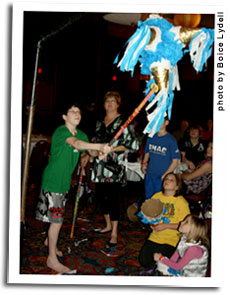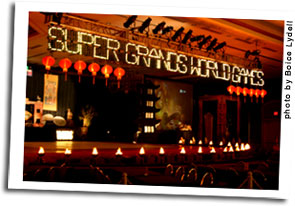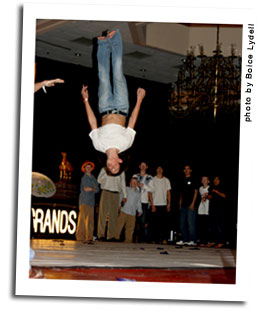 The year is 1990. Niagara Falls hosts the premier sport karate competition. Competitors across the United States and Canada traveled to the very first NBL Super Grands World Games to earn the very first and illustrious NBL world champion blackbelts. Fast forward nearly twenty years, and the 2009 rendition of the Super Grands finds itself on the Niagara Frontier once again, this time in Buffalo, New York. Past world champions returned, present super stars emerged and rivalries were born as the competition for the gold rings and belts waged on for nearly a week in the Adam’s Mark Hotel, in what arguably is the most exciting Super Grands to date.
The year is 1990. Niagara Falls hosts the premier sport karate competition. Competitors across the United States and Canada traveled to the very first NBL Super Grands World Games to earn the very first and illustrious NBL world champion blackbelts. Fast forward nearly twenty years, and the 2009 rendition of the Super Grands finds itself on the Niagara Frontier once again, this time in Buffalo, New York. Past world champions returned, present super stars emerged and rivalries were born as the competition for the gold rings and belts waged on for nearly a week in the Adam’s Mark Hotel, in what arguably is the most exciting Super Grands to date.
The World Games kicked off with the innovative World Team Sparring Challenge. Team GOP and Team All Stars represented the United States while both Mexico and Canada sported a team to combat the Americans. Team All Stars, featuring the enigmatic Raymond “The Real Deal” Daniels, and GOP were first to fight in the first round with All Stars advancing to the finals along with Team Mexico, who defeated Team Canada. It would be Team All Stars who would defeat Mexico to claim the challenge victory and add another accomplishment on their resume.
The Real Deal wasn’t the only returning champion of note. The Nash’s (Trevor and Casey) made a return to the Super Grands stage as well. Casey would return to the ring, crushing her competition, winning continuous sparring, female Japanese forms and female hard creative weapons. Her husband Trevor also made an impact winning heavyweight point fighting. Both Trevor and Casey plan to be back for the 2010 NBL season, so we are all looking forward to their continued return to prominence.
Last but certainly not least, Regina Thompson and Chris Gallio returned to the NBL scene after a year and three years off, respectively. Gallio led his team mercilessly against Team All Stars in a preliminary loss of the World Team Challenge. Gallio also led his team to a second place finish to All Stars for the men’s team world title. However, it would be Mr. GOP himself who would capture gold in the Middleweight Point Sparring competition. After three long years of hard work and rehabilitation from a devastating knee injury, Gallio reached the top yet again. His teammate, Thompson, would also claim world titles in her return to the ring. Thompson captured not only a point sparring world title, but the overall World Grand Championship after a tough fight with Casey Nash.

As great as it was to see these Super Grands legends return, it was equally as great to see the present stars of today in top form. The high flying Josh Durbin is an example of such a star. Durbin didn’t disappoint with the hype of his flashy tricks, as he brought home the Hard Creative Weapons world title, bringing his grand total to nineteen world title wins.
Jordan Simon of Team International is another highlight that every NBL competitor and fan knows. Simon is not only a creative weapons machine, but excels in the traditional categories as well. In fact, he has won two titles in both creative and traditional weapons; a claim not many can make. Not only does Simon posses twelve world titles over his career, he also boasts three World Overall Grands in as many years.
The Northcutt family has a household full of world title plaques, belts, and rings; literally. Between siblings Colbey, Sage, and Shaun, the Northcutt family boasts an incredible forty-nine world titles. Colbey and Sage have earned twenty-four each, the most amount ever won by any competitor, with up and coming Shaun holding his own with a world title in sparring in 2009. Sage does a little of everything, competing in traditional, contemporary and sparring divisions. His sister Colbey has shied away from the contemporary side in recent years, and now focuses on traditional and sparring competition. Young Shaun has focused on fighting throughout his brief sport karate career, but may yet rival his big brother and sister with forms one day. This Super Grands, the Northcutt family brought home titles in boys team sparring, girls team sparring, hard creative weapons, point sparring, continuous sparring, musical weapons, kempo, musical forms and Korean forms.
The most interesting part of the Super Grands is the Overall World Grand Championship, which has been a staple of the competition for the past three years. The four grand titles are awarded for contemporary and traditional forms (junior and adult), as well as men and women’s point sparring. Participants are selected from their scores in World Title competition and the highest scoring player from each category represents their respective division. The aforementioned Simon took home the Junior Contemporary Overall Grand after he performed his renown “Welcome to the Jungle” bo routine. Casey Nash dominated the Adult Traditional Overall Grand with her Japanese kata, cementing her above-mentioned return to the NBL. Newcomer Tan Nguyen not only won his first Japanese title this Super Grands, but he also stormed the stage to win the Junior Traditional Overall World Grand. Nguyen was accompanied by another newcomer, Austin Jorgensen, who would win both his first world title and overall grand this year. Jorgensen dominated the rest of the adult contemporary competitors with his drunken sword form. Finally, Regena Thompson and Willie Hicks would take home the women’s and men’s grands, respectively.

It was fitting for the 20th anniversary of the Super Grands to be on the same stomping grounds as the original. Sport karate competitors past and present appreciate the rich heritage of the Super Grands and it is amazing how it grows every year. One can only hope that the 21st rendition of the world competition rivals this one, albeit a very high standard set.
The Super Grands have run strong for the past twenty years and for the next twenty, competitors and fans can expect new rivalries, new stars, and past champions to grace the Super Grands stage, just as they have since 1990.